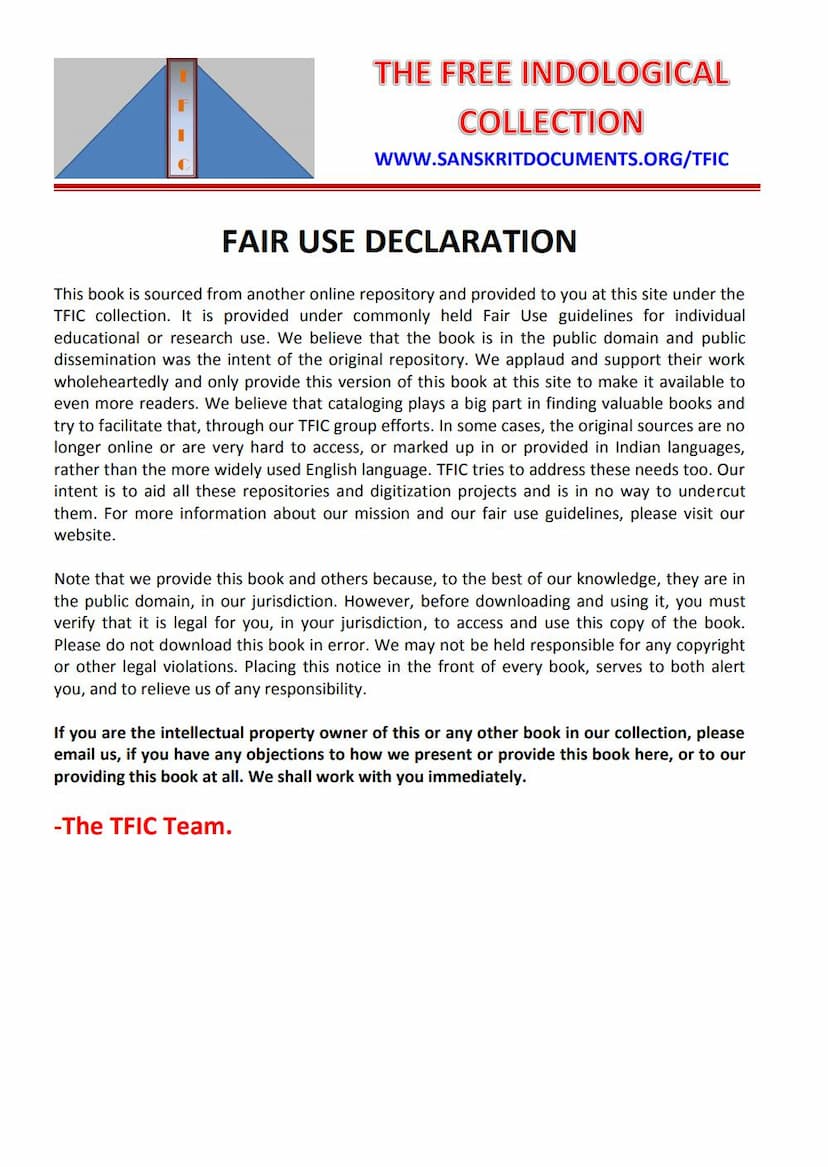Jain Siddhanta Kaumudi Purvardha
Added to library: September 2, 2025

Summary
Here's a comprehensive summary of the Jain text "Jain Siddhanta Kaumudi Purvardha" by Pandit Muni Shri Ratnachandraji Maharaj, based on the provided pages:
Book Title: Jain Siddhanta Kaumudi Purvardha (अर्धमागधी व्याकरणम् - Ardhamagadhi Vyākaraṇam) Author: Pandit Muni Shri Ratnachandraji Maharaj (भारत रत्न शतावधानी - Bharat Ratna Shatavadhani) Publisher: Shri Nagrajji Nahar, Jaipur (Dedicated in memory of late Shri Chandmalji Nahar) Language: The book is primarily in Sanskrit, with explanations and examples related to Ardhamagadhi grammar.
Core Purpose and Context:
This book is a grammar of the Ardhamagadhi language, which is considered the principal language of the Jain Agamas. The author highlights a long-standing debate among scholars regarding the language of the Jain scriptures: some argued it was "Prakrit" while others maintained it was "Ardhamagadhi." The book firmly establishes Ardhamagadhi as the specific language of the Jain Agamas, analogous to how Pali is the language of Buddhist scriptures. This is because the Tirthankaras preached and the Ganadharas compiled the scriptures in Ardhamagadhi.
The author emphasizes the crucial role of grammar and lexicography for understanding any language's literature. While various commentaries and translations of the Agamas exist, a dedicated grammar for Ardhamagadhi was lacking. Previous grammars, like those of Hemachandracharya and Chand, focused on other Prakrit dialects (like Maharashtrian Prakrit). Shri Ratnachandraji Maharaj undertook the significant task of filling this void, first by compiling an Ardhamagadhi lexicon over seven years and then by creating this grammar, "Jain Siddhanta Kaumudi."
Structure and Content:
The book is divided into several sections, as indicated by the table of contents (अनुक्रमणिका - Anukramanika):
-
संज्ञा प्रकरण (Sangya Prakaraṇam - Nomenclature/Classification): This section deals with the technical terms and classifications used in grammar. It covers the definition of vowels (स्वराः), consonants (व्यञ्जनानि), short vowels (हस्वाः), long vowels (दीर्घाः), identifying specific letters (e.g., kādi-māntāḥ sparśāḥ - consonants from 'ka' to 'ma'), the concept of upadha (the vowel preceding the final letter), anusvara (the nasalization mark), it-saṃjñā (letters that are dropped), lopa (dropping of sounds), and vṛddhi (vowel augmentation). The author provides Sanskrit sutras and explanations for each rule.
-
परिभाषा प्रकरण (Paribhasha Prakaraṇam - Grammatical Maxims/Rules of Interpretation): This section explains fundamental rules that govern the interpretation and application of grammatical rules. It includes principles like how to understand terms like hṛasva, dīrgha, and vṛddhi when they appear in relation to vowels, the concept of sthānyādeśa (where a modified element functions like the original), and rules for the dropping of sounds.
-
स्वरसन्धिप्रकरण (Svarasandhi Prakaraṇam - Vowel Sandhi): This chapter details the rules for the combination of vowels when words join. It covers rules for vowel augmentation (vṛddhi), vowel lengthening (dīrgha), and the concept of prakṛtibháva (maintaining the original vowel without change).
-
व्यञ्जनसन्धिप्रकरण (Vyanjanasandhi Prakaraṇam - Consonant Sandhi): This section explains how consonants change when they come together. It includes rules for parasavarṇa (assimilation of consonants to the following consonant), the dropping of consonants in clusters, and specific changes like 'd' to 'dh' and 's' to 'ch'.
-
स्वरविकारप्रकरण (Svaravikāra Prakaraṇam - Vowel Variations): This part discusses various modifications and changes that vowels undergo in different contexts. It covers changes like the insertion of 'y' or 'v', the modification of middle vowels, and the replacement of vowels with others.
-
व्यञ्जनविकारप्रकरण (Vyanjanavikāra Prakaraṇam - Consonant Variations): This section details the various changes and modifications that consonants undergo, such as the change of 'k' to 'g', 'g' to 'y', 'd'/'bh' to 'h', and the insertion or substitution of letters like 'n', 'l', 'd', and 'j'.
-
विभक्तिप्रकरण (Vibhakti Prakaraṇam - Inflection/Declension): This extensive section covers the declension of nouns and pronouns in Ardhamagadhi, detailing how they change based on case, number, and gender.
- पुल्लिङ्गशब्दा (Pulliṅga Śabdā - Masculine Nouns): It begins with masculine nouns, explaining the formation of singular, dual (though Ardhamagadhi largely uses singular and plural, the grammatical framework acknowledges this), and plural forms for various cases. Examples include jin (victor), goya (cowherd), and the common pronominal stem sarvanāma (pronouns).
- स्त्रीलिङ्गशब्दा (Strīliṅga Śabdā - Feminine Nouns): This part deals with feminine nouns, demonstrating their declensions. Examples include words like mālā (garland), diṭṭhi (sight), and samani (nun).
- नपुंसकलिङ्गाः (Napunsaka Liṅgāḥ - Neuter Nouns): This section covers the declension of neuter nouns, with examples like vaṇa (forest), dahi (yogurt), and mahu (honey).
- संख्यावाचकास्त्रिलिङ्गाः (Saṅkhyā Vācakāḥ Trilīṅgāḥ - Numerals in Three Genders): This part explains the formation of numbers and their agreement in gender. Examples include du (two) and tiss (three), and the cardinal numbers up to navanaui (ninety-nine).
Key Features and Contributions:
- Comprehensive Grammar: It provides a systematic and detailed grammatical analysis of Ardhamagadhi.
- Sanskrit Sūtras: The grammatical rules are presented in the form of Sanskrit aphorisms (sūtras), which is a traditional method in Indian linguistics.
- Explanations and Examples: Each rule is followed by clear explanations in Sanskrit and illustrative examples from Ardhamagadhi, often with their meanings or roots.
- Focus on Jain Agamas: The primary aim is to enable the study and understanding of the Jain scriptures by providing the grammatical foundation.
- Scholarly Approach: The author addresses scholarly debates and fills a significant gap in Jain linguistic studies.
- Dedicated Effort: The book is a testament to the author's immense dedication and scholarship, spanning many years of research.
- Commemorative Edition: The publication is dedicated to the memory of Shri Chandmalji Nahar, highlighting the support and appreciation of the Jain community for such scholarly endeavors.
In essence, "Jain Siddhanta Kaumudi Purvardha" is a foundational work for anyone wishing to study the Ardhamagadhi language, the sacred tongue of Jainism, and thereby gain a deeper understanding of the Jain Agamas.